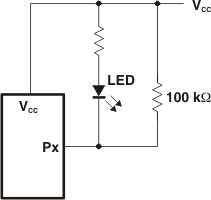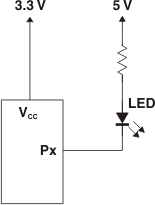JAJSPM4A September 2016 – February 2023 TCA6408A-Q1
PRODUCTION DATA
- 1 特長
- 2 アプリケーション
- 3 概要
- 4 Revision History
- 5 Pin Configuration and Functions
- 6 Specifications
- 7 Parameter Measurement Information
- 8 Detailed Description
- 9 Application and Implementation
- 10Device and Documentation Support
- 11サポート・リソース
- 12Mechanical, Packaging, and Orderable Information
9.2.1.2 Minimizing ICC When I/O is Used to Control LEDs
When the I/Os are used to control LEDs, normally they are connected to VCC through a resistor as shown in Figure 9-1. The LED acts as a diode, so when the LED is off, the I/O VIN is about 1.2 V less than VCC. The ΔICC parameter in the Section 6.5 table shows how ICC increases as VIN becomes lower than VCC. Designs that must minimize current consumption, such as battery power applications, must consider maintaining the I/O pins greater than or equal to VCC when the LED is off.
Figure 9-2 shows a high-value resistor in parallel with the LED. Figure 9-3 shows VCC less than the LED supply voltage by at least 1.2 V. Both of these methods maintain the I/O VIN at or above VCC and prevent additional supply current consumption when the LED is off.
 Figure 9-2 High-Value Resistor in Parallel With LED
Figure 9-2 High-Value Resistor in Parallel With LED Figure 9-3 Device Supplied by a Low Voltage
Figure 9-3 Device Supplied by a Low Voltage